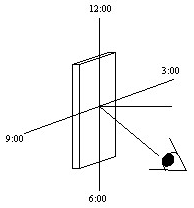Viewing Angle of an LCD
|
The viewing angle is the direction from which the display will have the maximum contrast and readability. Viewing direction is specified as positions of a clock face. A twelve o'clock viewing angle means that the optimum direction is above the normal to the display, while a part with a six o'clock viewing angle is best viewed from below the normal. A six o'clock viewing angle is shown in the figure below. This also implies that there is another angle away from the preffered viewing direction where the contrast will be a minimum. This direction is usually (but not always) 180o from the preferred veiwing angle. The contrast at this angle can be extremely low, and at worse it can be difficult to tell if the display is in its clear or opaque state. When specifying the viewing direction, one needs to think about how the device is going to be used. For example, a digital watch is usually on your wrist and viewed from the six o'clock direction . Some instrumentation, like a car clock, is usually mounted below the viewer and needs to be viewed from the twelve o'clock direction. Other viewing angles are possible but not common, see figure below.
The viewing angle is very critical when the display is multiplexed. The higher the multiplex rate, the greater the problem with the viewing angle. In displays with extremely high multiplex rates, great care must be taken when designing the drive circuitry. This can be done using commercially off the shelf driver chips that automatically set the drive bias voltages for a multiplexed display. Special films can also be applied to the front of the display glass to enhance the overall viewability, however they tend to be expensive. Contact us at (440) 232-8590 for help in designing your display for the best viewing angle. |

